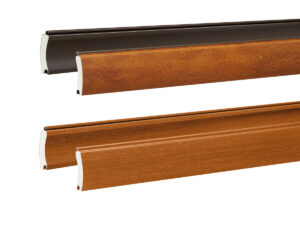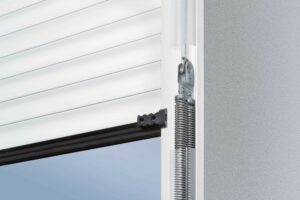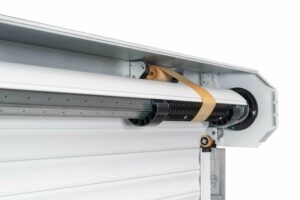Quality vs Economy: Understanding Roller Garage Doors
Are roller garage doors any good? The main difference between quality and economy is the price. Yet, it’s easy to think that one is as favourable as the next. Their rising popularity has led to advancements in technologies and design, but also a proliferation of basic, low budget products, where not all will meet the UK standards for quality and safety. With such wide variations, the adage “Basic or Best” has never been more apt especially when applied to the mechanics, materials, quality of the parts, the depth of the side guides, motor quality, construction of the laths, and type of automation and safety system. Therefore, it’s important to ask what you’re not getting for your money. Eastern Garage Doors examines the differences:
How they work
Roller garage doors are usually made from steel or aluminium slats or ‘laths’ that are formed in such a way that they slot into each other and form a pivot. This forms a flexible curtain which can curl around a drum above the opening to form a roll. The best doors are usually coated with a high-quality UV-resistant plastic offering abrasion-resistant surface protection. Guide channels on either side secure the curtain in place to ensure smooth travel. Automation is provided by a tubular operator, control unit and safety system, although manual operation is occasionally asked for.
The Curtain
Roller garage doors open vertically and offer maximum space inside and in front of the garage. Made out of slats (or lathes) in steel or aluminium, there are two choices, single skin, or double skin. When the door is opened, the series of slats coils into a roll above the garage opening without the need for tracks, guided via side channels to ensure smooth travel. Alternatively, if the garage has particularly low headroom (approx. 60 mm) there are also options which allow the curtain to be guided under the ceiling through narrow booms. The slats on high quality options like Hörmann also have curved profiles to make the rolling action much smoother.

Special abrasion-resistant curved surfaces on Hörmann profiles
General Comparison – Basic vs Best
Basic: Below £1200 – Single skin curtain constructed of metal, typically steel
Positives:
- Vertical operation saves driveway and internal garage space
Negatives:
- May not be CE marked.
- Curtain is made from thin material which can rattle in adverse weather conditions and are prone to denting and squashing, leading to potential misshaping.
- No insulation.
- May not be wind tested – Produces noise during operation, especially in inclement weather.
- Paint finish scuffs easily.
- Inferior gearing and limits can cause premature failure of motor.
- Non-existent or minimal use of brush strip material can provide a loose-fitting curtain and no sealability.
- Remote security – Poor signal strength can result in system hacking.
Best: £1800–£3200 – Slats consist of two layers of steel or aluminium with insulating material
Positives:
- CE marked.
- Vertical operation saves driveway and internal garage space.
- High-end security systems
- Profile is evenly filled with polyurethane rigid foam for added strength and aiding quiet door travel.
- Insulation can help to regulate temperature inside the garage.
- Resistant to impact – Thicker grade aluminium resists denting and flattening of lathes.
- Thick brush strips reduce noise levels and secure the curtain firmly inside the guide rails for a smooth operation.
- Aluminium door is lighter than steel. With less of a load placed on the door’s opening mechanisms this helps with longevity
- Wind tested & accredited.
- Tension springs support loadings and minimises wear and tear on the motor.
Negatives:
- Whilst there will be some draught exclusion, insulation properties are untested on a fitted door. Because the interlock between the laths/slats are not sealed they are unable to carry a meaningful U value. The gaps simply don’t prevent air and moisture from escaping. (other types of garage door are better, such as sectional garage doors and side hinged garage doors if you want a controlled environment such as a workshop or a home gym).
Wind Rating
A basic curtain, not designed to withstand wind, draws its inspiration from window shutters adapted for garage use. Consequently, it lacks wind shielding capabilities as it originates from a context where wind resistance wasn’t necessary, given the window itself acted as the protective barrier. Doors that are wind rated attach a label showing a particular wind speed classification. This is proof they have been professionally tested and approved for load compliance and will state a designed for wind speed. The minimum wind loading of 2 is for speeds just below 60 mph. A wind class 5 rating would mean it has been tested to withstand winds over 100 mph winds, suited to exposed coastal locations.
The Motor/Controller Component
The motor power required for a single roller door and a double roller door can vary based on the size and weight of the door, the mechanism used, and the frequency of use. It’s essential to consult with a professional installer to determine the exact motor power needed for a specific setup, as they can provide tailored recommendations. Factors such as insulation, wind load, and safety features may also influence the motor power selection.
Performance
A good roller door motor typically offers smoother and quieter operation compared to a cheap one. It may have more robust components that contribute to better performance, such as a higher torque motor or better gearing mechanisms. Good motors often provide consistent and reliable operation, opening and closing the door smoothly without jerky movements or unexpected stops.
Durability
Good roller door motors are designed to withstand frequent use over an extended period. They are often built with higher-quality materials and undergo rigorous testing to ensure durability. Cheap motors may use lower-quality materials and construction methods, leading to a shorter lifespan and potentially more frequent breakdowns, overheating, motor burnout, or electrical failures, leading to downtime and potentially costly repairs.
See the general differences below:
Basic
- 1–5 years motor life
- May not have obstacle detection.
- Fewer additional features
- Produces more noise.
- inferior gears and drives wear out quicker, loose tension or fail causing vibration.
Best
- 25–35 years motor life
- High opening speeds
- Integrated radio control
- Obstacle Detection
- Tamper Resistant
- Manual override
- Can incorporate noise reduction features especially beneficial if the garage is attached to living spaces, and noise minimisation is a priority.
- Soft start and soft stop
- Battery backup systems
- Smartphone integration for remote operation
- Enhanced security measures such as rolling code technology.
- Low power consumption in stand-by mode.
Beware the Bargain
Among the array of garage door types, roller garage doors stand out as the main offenders in misrepresenting the CE mark. Because of the simplicity of manufacturing basic models by sourcing materials from various suppliers, they can be poorly made to meet the bare minimum specification or less. They seldom adhere entirely to the requisite standards for a genuine CE certification and do not have wind testing certification. Always look for bona fide certification.
Safety Features
Most people would expect a new garage door to comply with safety regulations. But that’s not always the case. Built-in safety on the best doors comes in multiple forms including:
Light touch obstacle detection
In the event of the door closing and hitting an obstruction it will reverse back up avoiding people, cars or other objects becoming trapped. This can happen, for example, if the remote button is accidentally pressed whilst in your pocket.
Tension springs
The very best roller doors integrate tension springs which allow for smooth operation. These act as a counterbalance to the weight of the roller door curtain. When the door is opened manually or with a motorised system, the tension springs provide the necessary force to lift the door smoothly and evenly. This counterbalancing effect reduces the strain on the motor, making it last three times longer, and ensures that the door can be operated with minimal effort. This protects the operator mechanism and in the case of an emergency the door can be opened by hand without the need of a crank handle. These are sometimes made with multiple spring assemblies coupled with double lifting cables to prevent the door leaf from crashing.

Tension spring technology with spring-in-spring system on Hörmann RollMatic
The Safety Hood
An internal hood/barrel cover prevents people from reaching into the moving mechanism. In addition, it protects the curtain from damage and soiling when the door is open. This is mandatory up to two and half metres in height, and as most domestic installations are below this it is a must have. Not all basic entry level doors have these.
Insulation
The U-value standard, a measure of thermal efficiency, isn’t applied to roller doors due to the inherent design of their lathes and interlocking mechanism, resulting in unavoidable gaps. However, well-constructed roller garage doors typically incorporate double skin lathes filled with dense foam, capable of a degree of heat transfer reduction. Moreover, they include thick brush strips within the guide rails, sealing gaps and minimising noise during operation. In contrast, basic single skin options lack any insulation and utilise minimal seals, leading to heat loss and looser door movement.
Are electric roller doors secure?
Yes, superior quality roller doors are very secure. Reputable manufacturers extensively develop and test door security. The fact that there is no visible lock on an electric roller acts as its own deterrent. The better models use a combination of mechanisms to hold the curtain firmly in place. These can include built in auto locks, spring clamp devices, and anti-lift locking straps, housed within the barrel, which attach to the slats. The quality in these locking devices varies dramatically between manufacturers, so you might need to do a bit more homework to ensure the model you choose is up to the required standard. One certification to look out for is Secured by Design (SBD). This is a certificate awarded to products that have been independently tested and shown to withstand a forced entry attack. Conversely, a lot of cheaper roller garage doors don’t come with suitable locks. Instead of securely locking into place, the roller curtain can just hang in the guides from the barrel above it. Even if it’s held by straps, these can be substandard, and the curtain can be lifted open quite easily. High quality roller garage doors such as the RollMatic can be equipped with remote electronic systems which are exceptionally reliable and secure to 128 bits encryption, similar to online banking security. This level of investment in technology won’t be found in a basic sub £1200 door making it easier for them to be hacked.
The Guide Rails
Guide rails help to keep the door curtain properly aligned as it moves up and down. Generally, the higher the quality of the design and materials the more difficult it becomes to breakthrough a garage door. Special profile arrangements on high-end options have the surety of secure break-in resistant locking making it practically impossible to push the curtain open. Wind locks can also be standard on the best doors securing the curtain profiles in the guide tracks up to high wind loads (class 5). This is a category used in building design and construction to quantify the wind resistance capabilities of structures and building components. Professionally installed guide rails can help reduce noise during operation by ensuring that the curtain moves smoothly without rattling or vibrating against other surfaces. They can also help to secure the door curtain in place, preventing unauthorised access or tampering. Thus, making it more difficult for intruders to force the curtain out of the guide channel and gain entry to the premises. In low budget doors this critical feature can be compromised by substandard materials or manufacturing errors, which affect their strength and integrity, causing curtains to collapse sometimes with the minimum of manual force.
Are warranties all the same?
Basic systems may come with limited warranties reflecting their simpler design and functionality. The best systems have longer warranties, indicating the supplier’s confidence in the durability and performance of the motor, other moving parts, the door, and its finish. Look for 10-year product warranties as a sign of confidence in the product and workmanship guarantees of say five years for the installation. The best manufacturers and installers provide these because they’re assured in the services they offer. You’re also more likely to get a real person on the end of the phone should you need after sales support who are able to deal with the problem, take ownership of it and provide a resolution quickly and efficiently either offering guidance over the phone or by sending an engineer to site.
Designed-In Protection
With the best doors, maintenance features can be purposely designed-in to the fabric of the system. For example, additional surface protection as featured in Hörmann’s Durabelt system, are integral to the upkeep of the door. When rolling up, several belts are placed between the individual layers of the door curtain, significantly reducing scratch marks caused by natural soiling of the door curtain. Additionally, wear-resistant bearing rings also contribute to minimising marks on the inside of the profiles.

Hörmann DuraBelt system significantly reduces scratches.
Price
Price is a significant factor relative to the level of quality of manufacture on roller garage doors. Yet merely guaranteeing the lowest price holds little value if the product fails to meet expected standards. An eye-catching offer most probably means that many of the benefits are not included. Eastern Garage Doors advises consumers looking for a long-lasting product to be wary of roller doors with an installed price of less than £1200.
For further technical advice contact our experts 0800 048 0741.

